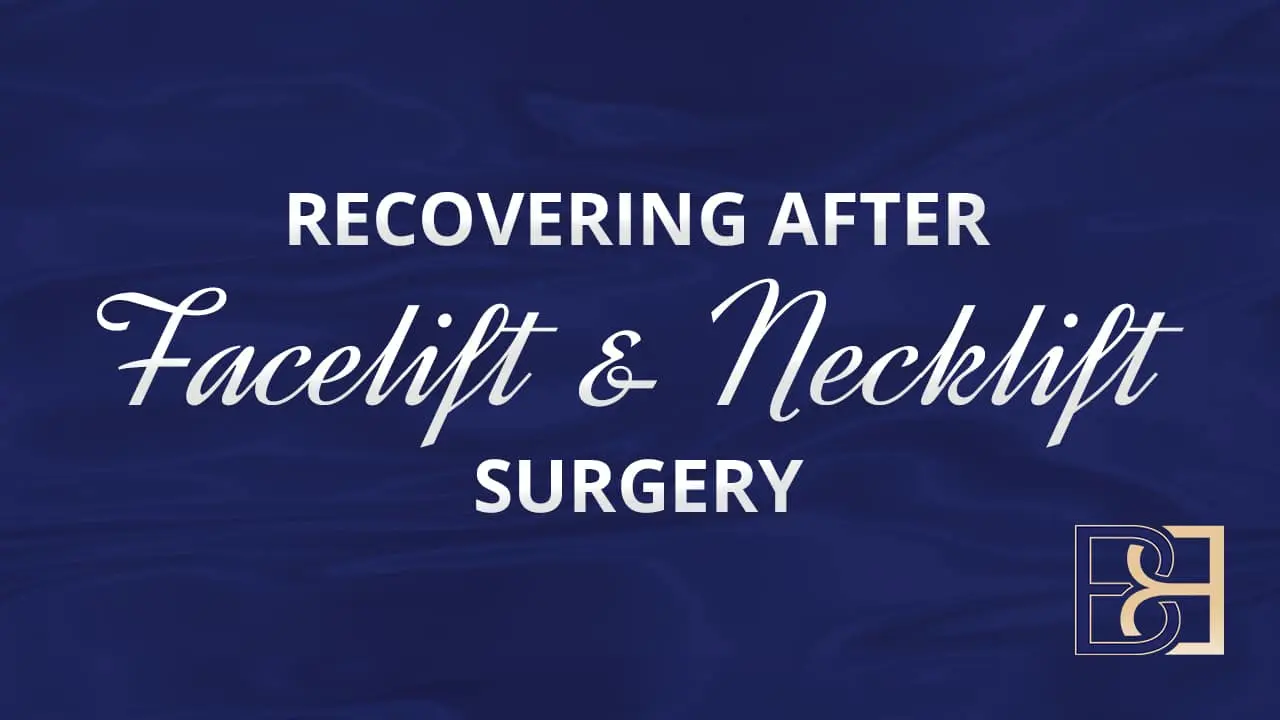Recovery after facelift surgery isn’t usually very long or stressful.
However, patients should be aware that results are not visible immediately. Normally the face looks a bit pale, swollen and bruised, possibly even worse than prior to surgery. Please keep in mind that this is normal, and should disappear in a few weeks.
The skin of the face may also feel numb but this should fade away at around two to three months, although the face will usually feel a bit tingly prior to sensation returning.
Usually there is mild pain after a facelift. This responds well to pain medications and Dr Beldholm usually provides a pain medication pack.
Book your appointment online now
Dr. Beldholm usually reviews patients the day after surgery. Facial bandages are removed at this stage along with drains or drainage tubes. Swelling and bruising is controlled by a head garment that puts pressure around the surgical sites.This head garment is measured up prior to the operation and is included in the post-operative care. Any oozing of fluids can be removed with pads. Facial stitches are removed around day seven after surgery. Any stitches around the scalp area may have to remain in longer as healing is slower in this area. Restricting exercise immediately after surgery and resting will limit the amount of bruising and swelling, although ** walking is fine after one or two days.
The healing process
Following facelift surgery, patients feel some pain for the first couple of days, especially when moving around or coughing. Although most patients are up and about in a day or two, it’s common for the face to ache occasionally for a couple of weeks.
Full recovery will take up to one month. During this recovery period you may feel tired as your body adjusts and heals. Patients may also experience random, shooting pains for a few months during the recovery process. The bandages are removed a day or two after your facelift, though patients continue wearing a supportive head garment around the clock for several weeks until the swelling and bruising subsides.
Activity should be kept to a minimum for a week or two, with only light activities such as ** walking or light home duties. No vacuuming or regular bending to pick things up should be performed during the first week.
Heavy lifting or pushing should also be avoided for three to four weeks following the procedure. If your facial skin becomes very dry, apply moisturiser several times a day, being careful to keep the suture area dry. As stamina levels will be reduced following your procedure, limit exercises to stretching, bending, and swimming until your energy increases. Please note that it is normal for a small amount of fluid to drain from the wound, or for some crusting to occur.
Return to work
Most patients can return to work and social activities at approximately two weeks after surgery, if their work is of a non-strenuous nature. However, please note, that at this time, there will still be bruising. This can usually be well hidden with makeup by this stage. Generally, this bruising should be gone by approximately week four. Patients whose work requires strong physical activity, may be wise to plan for four to six weeks of recovery time.
Getting back to normal is a gradual process that may take up to four to six weeks, and patience is very important during this healing process. Patients should be realistic about their expectations from facelift surgery, bearing in mind that the results are not noticeable straight away. Scars are concealed, usually hidden by the hair or by the natural lines of the face and ears. Either way, scars usually fade away to become fine lines and not visible unless closely looked at. Therefore, one should not be worried by visible scars during the healing process, as it usually takes six (and sometimes up to 12 months) for these to fade.
What to expect
Initially, your face may look different, as swelling and puffiness can change facial features. Bruising may also persist for up to a month. As the skin is very sensitive and numb soon after surgery, it also feels strange in the beginning. Additionally, patients may feel stiffness in facial movements and get exhausted very easily. In the first few months the face may feel hard and lumpy, but this usually settles down in around three to six months. There is not usually any visible lumps and the skin surface is usually smooth. It is only when you feel across the face that this firmness can be noted.
Usually by the end of the third or fourth week, patient appearance and mood have greatly **, with most able to return to work about two or three weeks after their procedure. At this stage, any remaining bruising can be masked with makeup. Special care should be taken with the face and hair during the recovery period.
Strenuous exercise, sexual intercourse and heavy housework should also be avoided for at least two weeks. Patients should remain alcohol-free for a few weeks postoperatively. Steam baths and saunas are also to be avoided for the same period. Hair around the temples may be thinner and facial skin dry and rough for a few months. Since the hair-growing skin is moved up behind the ears and neck during facelift procedures, men may then have to shave in these areas. Please note that men should avoid shaving for one week after the procedure.
Rhytidectomy surgery is frequently a great success, resulting in **-looking, firmer and tighter facial skin. A facelift, however, does not stop the ageing process. Consequently, a patient may require additional facelifts during his or her lifetime. Even so, it’s important to realise that the need for another procedure generally only becomes apparent after 10 to 20 years.




